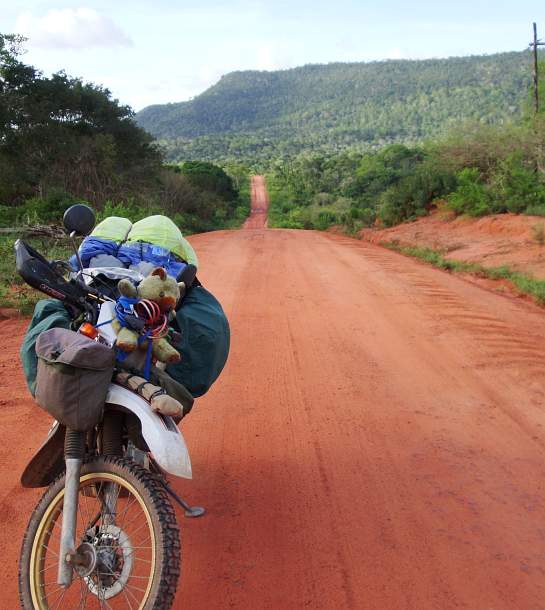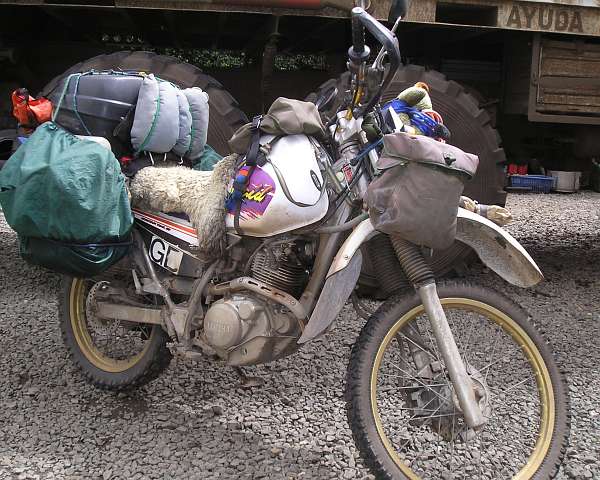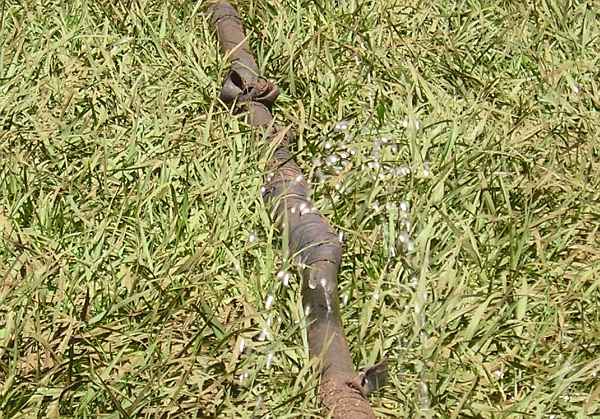Nairobi, Part 2
A couple of weeks ago we left Nairobi for Tiwi Beach on the Indian Ocean coast, south of Mombasa.
The road there took us between two National Parks, not completely fenced, so wildlife sightings can be expected almost anywhere.
About halfway to Mombasa a herd of zebra seem to live permanently by the roadside - they were still there when we returned a week later.
And a little further on something large was rummaging around in amongst the trees on the right hand side of the road.

It was an elephant's ear.

With elephant attached.

It wasn't completely oblivious of us, staring in our direction a couple of times and shuffling around warily.


The regular stream of heavy lorries zooming along between us seemed to convince him or her that a sudden charge across the road would be a little unwise, for us anyway.
It's a completely different experience seeing this sort of wildlife from the open road, as opposed to inside a commercial wildlife park with their pretty high entrance fees. From what we can tell from guidebooks and other visitors, entrance fees have tripled in three or four years, yet still the numbers of animals declines, except for a few particularly successful species.
So we watched our elephant doing lunch for a while before continuing, leaving the tarmac road nearer Mombasa.
There are two routes to Tiwi, on the tarmac through Mombasa where the potholes and the estuary car ferry cause suffocating traffic jams.
Or,

.... seventy miles of not-difficult dirt, mud and stones through a few nice little villages and the Shimba Hills.




Then our campsite on the beach.

It was hot and humid, not much below 30C by sunrise, but plenty of showers, swimming and beers on site.
And rain the night before we departed back to Nairobi, and most of the following day. A little late, we had found the rainy season!
The rain followed us off and on the three days back to Nairobi, where our journeys went in opposite directions.
Before we departed last year, Caroline and Beau decided that they would have to fly home from Nairobi to continue paid employment. Then return back here early in October to collect their bikes from storage and either go north to Khartoum if tentative job offers materialise, or continue on to Cape town.
They left their bikes at Jungle Junction on Friday night,
Caroline's Serow

Beau's TTR

and boarded a taxi for the airport and home.
So, congratulations to them on reaching Nairobi and Mombasa, and thanks for everything they contributed to the adventure. We hope it continues later in the year.
Now I'm planning my next steps, or turns of the wheels.
After the heat of the coast I'm drawn westwards towards Lake Victoria and Uganda. An option that comes with many recommendations from other travellers.
But I have a three-month Kenyan visa and three months road tax for the bike, which I might as well use up before leaving the country.
Particularly as I seem to find myself in the middle of a manic rush-hour.
The football World Cup starts soon, so the roads south, and the campsites, are full of overlanders heading for the big kick-off.
When we arrived at Jungle Junction at the end of last week there was hardly room for our two little tents and three little motorbikes. The place was crammed with massive overland trucks, 4X4s, cars and more motorbikes, plus a huge marquee tent housing a sizeable band of fans from Spain and Portugal. They were bedecked with colourful banners on their trucks campaigning to host the World Cup in 2018 and 2022.
And the rains continue. Which, I'm assured, become worse if you head west towards Uganda.
So I'm content at the moment to stay at the bikers' 'home from home' and let the football fans, their trucks and marquees, and the rains, go on ahead.
Then the next stop looks like the tea-growing region of western Kenya which seems to have particularly nice places to stay, followed by Lake Victoria and Uganda.
Internet is still a problem here, all the power went off at around 10am and now there's an angry thunder storm circling around. So don't know when contact with the outside world will recommence. There's a generator here, but only for the workshop (get the priorities right!) and I'm using a battery-operated device to get this update typed.
The Nairobi newspapers publish a full-page timetable each day for all the areas that will be without power between 9am and 5pm that day, and the local supermarket has TV screens showing which areas will be without water in the few days ahead.
Consequently this place has a few massive water tanks and pumps dotted around the house and yard that fill whenever there is water in the mains, so as to keep the toilets working for the sudden arrival of dozens of football fans. But in the last few days a water tanker has twice had to be brought in to keep the tanks full.
That's Africa.
Which leads to a little story I'll venture to include for anyone interested.
A few days ago one of Chris's mechanics set up an electric water pump screwed to the top of a vertical steel pipe that he'd attached to something down inside an underground manhole, situated in a large concrete slab by one the the camping areas.
A large and very old hose pipe ran from the pump along the ground towards the office annex building nearby. Then the hose disappeared somewhere beyond out of sight.
I happened to walk by at the same time as Chris, after the pump had been powered up.
"Is that a bore hole down there?" I innocently enquired, assuming he was trying to keep the water tanks full.
"The opposite, more or less," was the reply.
He then tried to politely explain that all the compound's sewerage was channelled into a large cavern under the concrete. There, "solids and liquids separate, the solids decay naturally, the liquids flow off into the land beyond the end wall over there, where nature takes care of that as well."
"But it's been raining so much the land over there can't take anymore liquid and it's backing up. So now and again we have to pump it over to the other side of the compound where the land is less waterlogged. It's an African solution! It means we're having sufficient rain this year."

The hosepipe is a magnificent African solution in itself, having thick insulating tape wrapped around it every ten inches or so, neatly tied in a bow here and there.

And hardly leaks at all.
Weather forecaster's footnote:
The other day Chris said the rains might be coming to an end. There'd been a couple of sunny days (but still with some rain), and his tortoise had come out of hibernation.
"Not a reliable sign - it's not a Kenyan tortoise, and as there's no winter here, the local ones don't hibernate anyway. But we can always hope!"
Now I notice that the staff have rolled up the large carpet in the lounge and stacked it away in the corner. Not a sign that they expect dry weather to break out soon.
